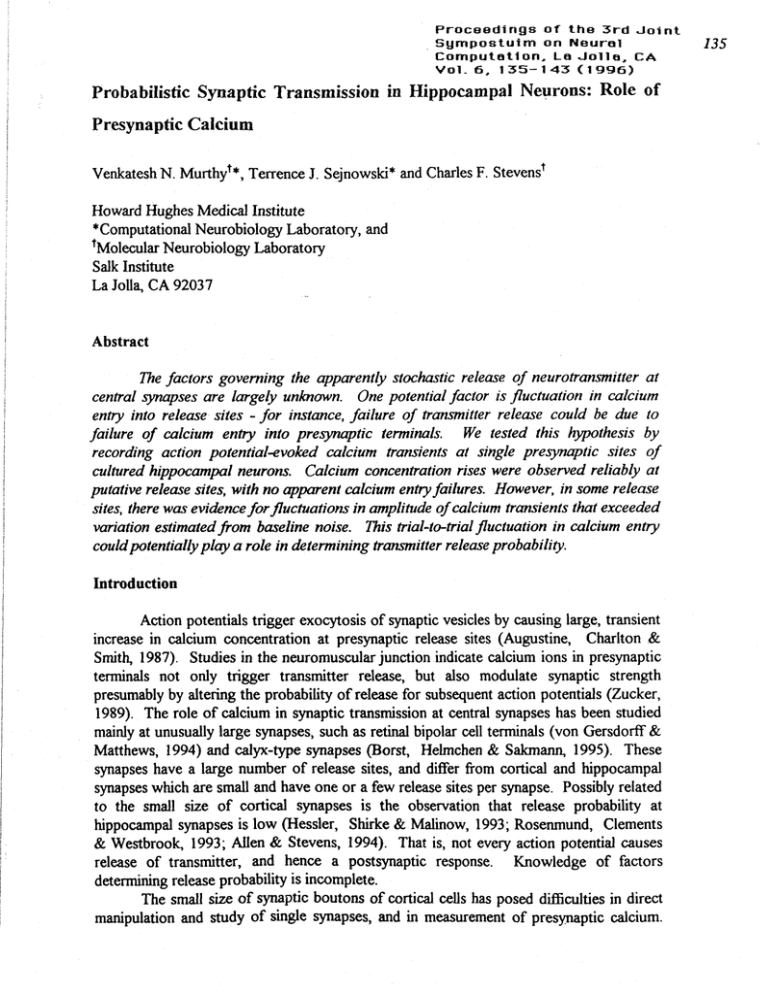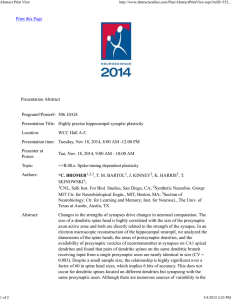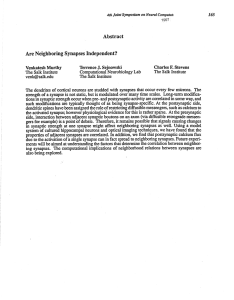Document 10478045
advertisement

Proceedings of t h e 3rd J o i n t Sympostuim on Neural Computetion, La J o l l a , CA V o l . 6, 1 3 5 - 1 4 3 i 1 9 9 6 ) Probabilistic Synaptic Transmission in Hippocampal Neurons: Role of Presynaptic Calcium Venkatesh N. ~ u r t h ~ ' *Terrence , J. Sejnowski* and Charles F. stevens' Howard Hughes Medical Institute *Computational Neurobiology Laboratory, and t~olecularNeurobiology Laboratory Salk Institute La Jolla, CA 92037 Abstract lie factors governing the apparently stochastic release of neurotransmitter at central synapses are largely unknown. One potential factor is fluctuation in calcium entry into release sites - for instance, failure of transmitter release could be due to failure of calcium entry into preynaptic terminals. We tested this h p t h e s i s by recording action potential-evoked calcium transients at single presynaptic sites of cultured hippocampal neurons. Calcium concentration rises were observed reliably at putative release sites, with no apparent calcium entryfailures. However, in some release sites, there was evidenceforf7uctuations in amplitude of calcium transients that exceeded variation estimated @om baseline noise. This trial-to-trial fluctuation in calcium entry could potentially play a role in determining transmitter release probability. Introduction Action potentials trigger exocytosis of synaptic vesicles by causing large, transient increase in calcium concentration at presynaptic release sites (Augustine, Charlton & Smith, 1987). Studies in the neuromuscular junction indicate calcium ions in presynaptic terminals not only trigger transmitter release, but also modulate synaptic strength presumably by altering the probability of release for subsequent action potentials (Zucker, 1989). The role of calcium in synaptic transmission at central synapses has been studied mainly at unusually large synapses, such as retinal bipolar cell terminals (von Gersdorff & Matthews, 1994) and calyx-type synapses (Borst, Helrnchen & Sakmann, 1995). These synapses have a large number of release sites, and differ fiom cortical and hippocampal synapses which are small and have one or a few release sites per synapse. Possibly related to the small size of cortical synapses is the observation that release probability at hippocampal synapses is low (Hessler, Shirke & Malinow, 1993; Rosenmund, Clements & Westbrook, 1993; Allen & Stevens, 1994). That is, not every action potential causes release of transmitter, and hence a postsynaptic response. Knowledge of factors determining release probability is incomplete. The small size of synaptic boutom of cortical cells has posed difficulties in direct manipulation and study of single synapses, and in measurement of presynaptic calcium. 135 136 3rd Joint Symposium on Neural Compulation Proceedings Some studies have overcome this problem by monitoring responses at populations. The role of presynaptic calcium has been studied at hippocampal CA3-CAI synapses (Wu & Saggau, 1994) and at cerbellar granule cell-Purkinje cell synapses Wntz, Sabatini & Regehr, 1995). Although measurement of optical signals fiom populations of synapses has yielded valuable infomation about average properties of synapses, a strong body of evidence indicates that synapses are highly heterogeneous in terns of fbndamental properties such as the types of calcium channels they possess (Wheeler, Randall & Tsien, 1994; Reuter, 1999, the probability of transmitter release in response to action potentials (Hessler et al., 1993; Rosenrnund et al., 1993; Allen & Stevens, 1994) and the distribution of postsynaptic receptors (Bekkers & Stevens, 1989; Isaac, Nicoll & Malenka, 1995; Liao, Hessler & Malinow, 1995). Therefore, it is of importance to study synaptic transmission at single synapses. Recently, the methods of minimal stimulation in slices (Raastad, 1995; Stevens & Wang, 1995) and local perfhion in cultured neurons have allowed direct electrophysiological study of single synapses (Bekkers & Stevens, 1991; Liu & Tsien, 1995; Stevens & Tsujimoto, 1995). In addition, the styryl dye FM1-43 (Betz & Bewick, 1992) has been used to study vesicle turnover at single synapses (Ryan et al., 1993; Ryan & Smith, 1995). Similar studies of calcium dynamics at single synapses would be important in elucidating the role of calcium in transmitter release and synaptic plasticity. It will also allow direct determination of the contribution of different calcium channel types to calcium entry and vesicle release at these synapses. We have developed a technique in cultured hippocampal neurons that allows us to visualize and study calcium dynamics in axons and in individual release sites. We find that in response to single action potentials, clear and abrupt rises in calcium can be detected at preynaptic sites, which then decay rapidly to baseline. These transients summate when multiple action potentials are evoked in succession. Fluctuations in calcium responses could not be fblly accounted for by baseline variability. These fluctuations could, in principle, contribute to the uncertainty of release on a trial-by-trial basis. Methods Culture preparation: Hippocampal neurons were cultured using the methods described previously (Bekkers & Stevens, 1991). Briefly, small blocks of hippocampal tissue fiom newborn rats were dissociated into single-cell suspension and centfiged through a balanced salt solution. The pellet was resuspended in growth medium and plated onto glass coverslips coated with collagedpoly D-lysine. Cultures were allowed to mature for 10-24 days before recordings were made. Electroph~siology:The whole-cell patch clamp configuration was used to fill neurons with 100-250 pM fluo-3 and to evoke action potentials. The patch pipette solution contained (in mM): 120 KGlu, 10 KCl, 5 Mg-ATP, 0.3 GTP, 10 NaCl and 100-250 p M fluo-3. Cells were perfused with extracellular medium containing (in mM): 136 NaC1, 2.5 KC1, 10 glucose, 10 HEPES, 2 CaCI2 and 2 MgC12. For most recordings (except where mentioned), 10 pM DNQX, 50 p.M D-APV and 100 pM picrotoxin were included in the medium to prevent synaptically evoked postsynaptic calcium transients. Data were 3rd Joint Symposium on Neural Computation Proceedings acquired with a Pentium 90 MHz computer (Dell) using a National Instruments board (AT-MIO- 16) and software (Labview). Imaning and Analysis: Recordings were made on a Zeiss WL upright microscope with the recording chamber and electrode holders attached to a movable stage. Imaging was done using BioRad MRC-600 confocal laser scanning microscope. The fluorescein filter cubes were used for imaging, and a second photomultiplier was used to detect the transmitted signal which provided bright-field images of the preparation. A 40X, 0.75 NA water immersion obective (Zeiss) was used for imaging. Images were acquired by a PC using software provided by BioRad (SOM). After an area of interest was found, images were acquired in the line-scan mode which allowed a temporal resolution of 4 ms. To confirm that the varicosities imaged were indeed release sites, in some experiments presynaptic sites were stained with the styryl dye FM4-64. FM4-64, which is structurally similar to FM1-43 (Betz & Bewick, 1992) labels release sites which undergo vesicle turnover. FM4-64 was used instead of FM1-43 (which is the standard dye used in synaptic studies) because its emission spectrum is at longer wavelengths, allowing it be distinguished fiom fluo-3 emission. Medium containing 5 pM FM4-64 was perfused while the neuron was stimulated with the whole-cell patch pipette at 5 Hz for 60 sec. After washing with normal medium for over 5 minutes, dual channel fluorescence images were obtained using filter cubes corresponding to fluorescein and rhodarnine wavelengths (A1 and A2 filter sets on the BioRad MRC-600). Images were analyzed with custom-written software using MATLAB. Regions of interest were defined and pixels were averaged for each line scan yielding 1 point every 4 ms. Image data were aligned with electrophysiological data by sending TTL pulses fiom the confocal scan control to the data acquisition program Labview. Results Figure 1 shows the fluorescence image of a neuron filled with 150 pA4 fluo-3. In addition to bright dendritic processes, several small calibre branching processes with varicosities are observed. These varicosities were always adjacent to other processes (fiom other cells), presumably dendrites on to which synapses are formed. Simultaneous labeling with the vesicle dye FM4-64 indicated that many of these varicosoties are likely to be presynaptic release sites. In order to follow rapid changes in calcium concentration, imaging was performed using the line-scan mode of the laser scanning confocal microscope. From a fiame scan image of the neuron, a line was chosen to include the presynaptic varicosity. This line was scanned 100 to 200 times at a rate of 4 rns per line. Following action potentials evoked at the soma, the calcium concentration at the varicosity increased transiently (peak fluorescence change was 20% of baseline). The rise time was less than the time resolution of the scans (4 ms), and the initial part of decay was well-fit by a single exponential with T = 150 ms. The average values of peak intensity and time constant for 30 boutons analyzed to date were 12.4 f 2.2 % and 124 f 11 ms (Figure 2). In some cases, the line scan included the axonal area adjacent to the varicosity. For these recordings, the peak calcium transients in axons were much smaller than those in varicosities (Figure 1). 137 3rd Joint Symposium on Neural Computation Proceedings Figure 1: Example of calcium transient recorded at putative presynaptic release site. (a) Image of neuron filled with 150 pM fluo-3. Note the fine highly branching processes that are faintly stained and running in close apposition to dendrites. Electrical recording indicated that the axon made many autapses, giving rise to a large synaptic current. (b) The area in the white box above is enlarged. A series of line scans were obtained through the line indicated. The average fluorescence change in 14 pixels overlying the varicosity (corresponding to 2 pm), and a region of the axon that is not bright is shown at bottom right. (c) At time 0 ms and and 100 ms action potentials were elicited by stepping the voltage in the soma to 0 mV from -70 mV for 1 ms. Note the abrupt rise in fluorescence in the varicosity followed by a rapid decay. In the neighboring axonal region, fluorescence transients were inuch smaller. - Responses evoked by action potentials could be recorded for up to 50 trials in some boutons. This allowed the estimation of trial-to-trial variability in the evoked responses at single release sites. Figure 3 shows the calcium response at a putative release site. Every action potential caused a rise in calcium at this varicosity. Of 30 varcosities that had detectable changes in fluorescence in response to single action potentials, every trial in every varicosity caused a change in fluorescence indicating calcium entry. Our 3rd Joint Symposium on Neural Computation Proceedings experiments indicate that calcium enters the terminal during every action potential. Since a majority of these synapses are known to have low release probabilities under conditions identical to ours, it is unlikely that we were recording exclusively from high probability synapses. 0 10 20 Peak hF/F x 100 (%) 30 0 100 200 Time constant (ms) Figue 2: Parameters of evoked fluorescence transients in single presynaptic sites. For each site, the normalized peak of transients were estimated from average responses as the difference between peak and baseline, normalized to the baseline. Decay time constants were estimated by fitting single expontentials to averages for each site. Only 13 of 30 boutons had su&cient signal to noise over a period of 100 ms or more to obtain meaningful estimates for decay time constant. We used the following procedure to determine the extent of trial-to-trial fluctuation in calcium entry. The integral of the response was obtained after subtracting the fluorescence intensity in the baseline period. To obtain a control measure to compare the responses against, the baseline period was divided into two parts. For each trial, the first half of the prestimulus period was taken as baseline and the second half integrated. The variability of the integrated response was then compared with the variability of the integrated baseline. (Figure 3c). Preliminary analysis has indicated that in 5 of 5 boutons the variability of responses was larger than that predicted by baseline variability (Table 1) Table 1 Bouton # CVbaseline (%) CVresponse (%) Mean: CVresponse CVbaseline 1.41 If: 0.31 139 I40 3rd Joint Symposium on Neural Computation Proceedings Figure 3: Variability of calcium response at single presynaptic sites. (a) A zoomed in view of the dendritic processes and axon of a neuron containing fluo-3. The faint process with hotspots is the axon. (b) Fluorescence changes in the varicosity enclosed by the box at top. Overlaid are 20 responses to single action potentials. The lines at the bottom labeled a and b are indicate the periods over which the fluorescence was integrated (see text). (c) Integrated fluorescence for both the baseline period x and the response y. The coefficient of variation of the integrated response was around 40% greater than that of the baseline. Discussion The main conclusion from our experiments is that complete failure of calcium entry into presynaptic terminal during action potentials is unlikely to be the primary determinant of low release probability at hippocampal synapses. This is in agreement with a recent study using cortical cultures (Mackenzie, Umemiya & Murphy, 1996), but in opposition to proposals that lack of calcium entry into presynaptic release sites could cause failure of transmitter release (Burns & Augustine, 1995; Frenguelli & Malinow, 1995). Since cortical synapses are small structures, it is possible that only a small number of calcium channels are available for activation by action potentials. Since the probability of all channels failing to open during an action potential increases with decreasing number of channels (assuming independence among channels), the smaller synapses might be 3rd Joint Symposium on Neural Computation Proceedings expected to show failure of calcium entry. This was not the case. Reliable entry was detected in all boutons analyzed, independent of the magnitude of calcium transient. While we find that evoked calcium entry at putative release sites is reliable, it remains to be determined if trial-to-trial fluctuations in the amount of calcium entering the terminals can affect release probability. For instance, the variability seen in our experiments couId still affect release since release probability has a power-law dependence on the concentration of calcium at other synapses (Dodge & Rahamimoff, 1967). Further experiments are necessary to evaluate whether the measured variability does in fact cause changes in release probability. Another possibility that cannot be ruled out by these measurements is that the concentration of calcium that is relevant to release is not directly reflected by the average cytoplasmic levels our method measures. Calcium near the plasma membrane may also have greater amplitude fluctuations that occur at a shorter time scale than reported here. From the same logic used above (smaller terminals have fewer calcium channels), it can be argued that boutons with smaller calcium transients will have greater variability. Preliminary analysis has not revealed any correlation between the mean amplitude of the response and the degree of variability. However, fbrther experiments are necessary to hlly address this issue. Acknowledgment: We thank Chris Boyer for culturing neurons used in the experiments. TJS and CFS are Investigators at the Howard Hughes Medical Institute. Research was also supported through NIH grants to TJS and CFS. VNM is a Helen Hay Whitney Foundation fellow. References Allen, C. and Stevens, C. F. (1994). An evaluation of causes for unreliability of synaptic transmission. Proc Natl Acad Sci U S A 91(22), 10380-3. Augustine, G. J., Charlton, M. P. and Smith, S. J. (1987). Calcium action in synaptic transmitter release. Anrm Rev Neurosci 10, 633-93. Bekkers, J. M. and Stevens, C. F. (1989). NMDA and non-NMDA receptors are colocalized at individual excitatory synapses in cultured rat hippocampus. Nature 341(6239), 230-3. Bekkers, J. M. and Stevens, C. F. (1991). Excitatory and inhibitory autaptic currents in isolated hippocampal neurons maintained in cell culture. Proc NatZ Acad Sci U S A 88(17), 7834-8. Betz, W. J. and Bewick, G. S. (1992). Optical analysis of synaptic vesicle recycling at the frog neuromuscular junction. Science 255(504 l), 200-3. Borst, J. C. G., Helmchen, F. and Sakmann, B. (1995). Pre- and postsynaptic whole-cell recordings in the medial nucleus of the trapetiod body of the rat. . I Physiol. 489(3), 825840. 141 142 3rd Joint Symposium on Neural Computation Proceedings Bums, M. E. and Augustine, G. J. (1995). Synaptic structure and fknction: dynamic organization yields architectural precision. Cell 83(2), 187-94. Dodge, F. A. and Rahamimoff, R. (1967). Co-operative action of calcium ions in transmitter release at neuromuscular junction. JmrnaI of Physiology 193, 419-432. Frenguelli, B. G. and Malinow, R. (1995). Fluctuations in evoked calcium responses at central presynaptic terminals. Societyfor Neuroscience Annual Meetings 2 1 , 332. Hessler, N. A., Shirke, A. M. and Malinow, R. (1993). The probability of transmitter release at a mammalian central synapse. Nature 366(6455), 569-72. Isaac, J. T., Nicoll, R. A. and Malenka, R. C. (1995). Evidence for silent synapses: implications for the expression of LTP. Neuron 15(2), 427-34. Liao, D., Hessler, N. A. and Malinow, R. (1995). Activation of postsynaptically silent synapses during pairing-induced LTP in CA1 region of hippocampal slice. Nature 375(6530), 400-4. Liu, G. and Tsien, R. W. (1995). Properties of synaptic transmission at single hippocampal synaptic boutons. Nature 375(6530), 404-8. Mackenzie, P. J., Umemiya, M. and Murphy, T. H. (1996). Ca2+ imaging of CNS axons in culture indicates reliable coupling between single action potentials and distal hnctional release sites. Neuron 16, 783-795. Mintz, I. M., Sabatini, B. L. and Regehr, W. G. (1995). Calcium control of transmitter release at a cerebellar synapse. Neuron 15(3), 675-88. Raastad, M. ( 1995). Extracellular activation of unitary excitatory synapses between hippocampal CA3 and CAI pyramidal cells. Eur JNeurosci 7(9), 1882-8. Reuter, H. (1995). Measurements of exocytosis fiom single presynaptic nerve terminals reveal heterogeneous inhibition by Ca(2+)-channel blockers. Neuron 14(4), 773-9. Rosenmund, C., Clements, J. D. and Westbrook, G. L. (1993). Nonuniform probability of glutamate release at a hippocarnpal synapse. Science 262(5 134), 754-7. Ryan, T. A., Reuter, H., Wendland, B., Schweizer, F. E., Tsien, R. W. and Smith, S. J. (1993). The kinetics of synaptic vesicle recycling measured at single presynaptic boutons. Neuron 11(4), 7 13-24. Ryan, T. A. and Smith, S. J. (1995). Vesicle pool mobilization during action potential firing at hippocarnpal synapses. Neuron 14(5), 983-9. 3rd Joint Symposium on Neural Computation Proceedings Stevens, C. F. and Tsujimoto, T. (1995). Estimates for the pool size of releasable quanta at a single central synapse and for the time required to refill the pool. Proc Natl Acad Sci U S A 92(3), 846-9. Stevens, C. F. and Wang, Y. (1995). Facilitation and depression at single central synapses. Neuron 14(4), 795-802. von Gersdofl, H. and Matthews, G. (1994). Inhibition of endocytosis by elevated internal calcium in a synaptic terminal. Nature 370(649l), 652-5. Wheeler, D. B., Randall, A. and Tsien, R. W. (1994). Roles of N-type and Q-type Ca2+ channels in supporting hippocampal synaptic transmission [see comments]. Science 264(5155), 107-1 1 . Wu, L. G. and Saggau, P. (1994). Presynaptic calcium is increased during normal synaptic transmission and paired-pulse facilitation, but not in long-term potentiation in area CAI of hippocampus. J Neurosci 14(2), 645-54. Zucker, R. S. (1989). Short-term synaptic plasticity. Annu Rev Neurosci 12, 13-3 1 143







